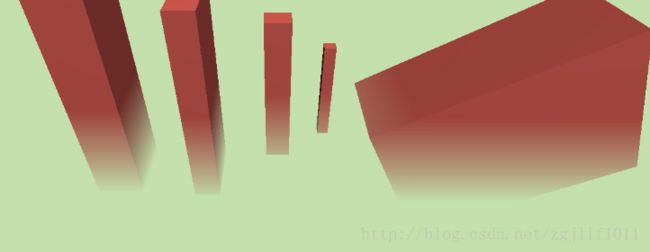Unity中实现类似纪念碑谷中地面的雾化效果
看一下纪念碑谷中的这个效果:
想要实现一个这种地面的雾化效果,在网上找了很久,也没找到满意的解决方案,最后只能自己做一个了。
首先想到的就是shader,思路就是从y坐标=0开始往下的位置都使用雾的颜色,中间过度部分用原颜色和雾的颜色做一个插值即可。但是因为是整个游戏的效果,肯定不能只作用在某一个模型上,所以只能使用后期特效,后期特效的话就会有一个问题,如何获取像素点的世界坐标,于是我就搜索到了这篇文章:http://blog.csdn.net/zzxiang1985/article/details/59581376
思路就是通过深度贴图中的深度,进行一次与世界坐标投影到屏幕坐标相反的操作,即可得到原世界坐标,
获取世界坐标的shader代码如下:
float4 GetWorldPositionFromDepthValue( float2 uv, float linearDepth )
{
float camPosZ = _ProjectionParams.y + (_ProjectionParams.z - _ProjectionParams.y) * linearDepth;
// unity_CameraProjection._m11 = near / t,其中t是视锥体near平面的高度的一半。
// 投影矩阵的推导见:http://www.songho.ca/opengl/gl_projectionmatrix.html。
// 这里求的height和width是坐标点所在的视锥体截面(与摄像机方向垂直)的高和宽,并且
// 假设相机投影区域的宽高比和屏幕一致。
float height = 2 * camPosZ / unity_CameraProjection._m11;
float width = _ScreenParams.x / _ScreenParams.y * height;
float camPosX = width * uv.x - width / 2;
float camPosY = height * uv.y - height / 2;
float4 camPos = float4(camPosX, camPosY, camPosZ, 1.0);
return mul(unity_CameraToWorld, camPos);
}
fixed4 GetWorldPos(float2 uv){
float rawDepth = SAMPLE_DEPTH_TEXTURE( _CameraDepthTexture, uv );
// 注意:经过投影变换之后的深度和相机空间里的z已经不是线性关系。所以要先将其转换为线性深度。
// 见:https://developer.nvidia.com/content/depth-precision-visualized
float linearDepth = Linear01Depth(rawDepth);
fixed4 worldpos = GetWorldPositionFromDepthValue( uv, linearDepth );
return worldpos;
}然后实现我们的fragment方法:
float4 frag( v2f_img o ) : COLOR
{
//获取世界坐标
fixed4 worldpos = GetWorldPos( o.uv);
fixed4 renderTex = tex2D(_MainTex, o.uv);
fixed y = worldpos.y;
//上下变色
fixed tmp = step(0,y);
fixed lp1 = - y / _ChangeDis;
fixed lp = lp1 * (1-tmp) ;
fixed4 c = _Color * (1-tmp);
return lerp(renderTex ,c,min(lp,1)) ;
} 因为这里我们需要获取深度贴图,所以我们还要设置一下摄像机的模式:
GetComponent().depthTextureMode = DepthTextureMode.Depth; 最后来看看效果:
下面给出完整的shader代码
Shader "Custom/FotTest" {
Properties {
_MainTex ("Base (RGB)", 2D) = "white" {}
_Color ("Ground Color", Color) = (1,0,1,1) //颜色
_ChangeDis ("Change Dis", float) = 3.0 //渐变速度
}
SubShader {
Tags { "RenderType"="Opaque" }
LOD 200
Pass{
CGPROGRAM
#include "UnityCG.cginc"
#pragma vertex vert_img
#pragma fragment frag
uniform sampler2D _MainTex;
uniform fixed4 _Color;
uniform float _ChangeDis;
sampler2D _CameraDepthTexture;
float4 GetWorldPositionFromDepthValue( float2 uv, float linearDepth )
{
float camPosZ = _ProjectionParams.y + (_ProjectionParams.z - _ProjectionParams.y) * linearDepth;
// unity_CameraProjection._m11 = near / t,其中t是视锥体near平面的高度的一半。
// 投影矩阵的推导见:http://www.songho.ca/opengl/gl_projectionmatrix.html。
// 这里求的height和width是坐标点所在的视锥体截面(与摄像机方向垂直)的高和宽,并且
// 假设相机投影区域的宽高比和屏幕一致。
float height = 2 * camPosZ / unity_CameraProjection._m11;
float width = _ScreenParams.x / _ScreenParams.y * height;
float camPosX = width * uv.x - width / 2;
float camPosY = height * uv.y - height / 2;
float4 camPos = float4(camPosX, camPosY, camPosZ, 1.0);
return mul(unity_CameraToWorld, camPos);
}
fixed4 GetWorldPos(float2 uv){
float rawDepth = SAMPLE_DEPTH_TEXTURE( _CameraDepthTexture, uv );
// 注意:经过投影变换之后的深度和相机空间里的z已经不是线性关系。所以要先将其转换为线性深度。
// 见:https://developer.nvidia.com/content/depth-precision-visualized
float linearDepth = Linear01Depth(rawDepth);
fixed4 worldpos = GetWorldPositionFromDepthValue( uv, linearDepth );
return worldpos;
}
float4 frag( v2f_img o ) : COLOR
{
//获取世界坐标
fixed4 worldpos = GetWorldPos( o.uv);
fixed4 renderTex = tex2D(_MainTex, o.uv);
fixed y = worldpos.y;
//上下变色
fixed tmp = step(0,y);
fixed lp1 = - y / _ChangeDis;
fixed lp = lp1 * (1-tmp) ;
fixed4 c = _Color * (1-tmp);
return lerp(renderTex ,c,min(lp,1)) ;
}
ENDCG
}
}
}public class MainCamera : MonoBehaviour {
public Material m;
Camera mainCamera;
public Color newColor;
public float distance;
// Use this for initialization
void Start () {
m.SetColor("_Color", newColor);
m.SetFloat("_ChangeDis", distance);
GetComponent().depthTextureMode = DepthTextureMode.Depth;
}
// Update is called once per frame
void Update () {
}
void OnRenderImage(RenderTexture src, RenderTexture dest)
{
Graphics.Blit(src, dest, m);
}
} 
